|
List of birds of Hawaii
 This list of birds of Hawaii is a comprehensive listing of all the bird species seen naturally in the U.S. state of Hawaii as determined by Robert L. and Peter Pyle of the Bishop Museum, Honolulu, and modified by subsequent taxonomic changes.[1][2] The scope of this list encompasses the entire Hawaiian Islands chain, from Kure Atoll in the Northwestern Hawaiian Islands to the north, to the "Big Island" of Hawaii to the south. The list contains 337 species. Of them, 64 are or were endemic to the islands, 130 are vagrants and 52 were introduced by humans. Thirty-three of the 64 endemic species are extinct and two formerly established introduced species were extirpated. The list does not include introduced species that have not become established. An additional vagrant species has been added from another source. This list is presented in the taxonomic sequence of the Check-list of North and Middle American Birds, 7th edition through the 63rd Supplement, published by the American Ornithological Society (AOS).[2] Common and scientific names are also those of the Check-list, except that native Hawaiian spelling is used where appropriate and the common names of families are from the Clements taxonomy because the AOS list does not include them. The following codes define the distribution and relative abundance of species on this list:
Population status symbols are those of the Red List published by the International Union for Conservation of Nature (IUCN).[3] Except for endemic species, the symbols apply to the species' worldwide status, not their status solely in Hawaii or the status of listed Hawaiian subspecies. The symbols and their meanings, in increasing order of peril, are:
Ducks, geese, and waterfowl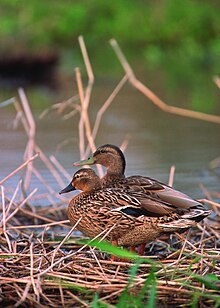  Order: Anseriformes Family: Anatidae The family Anatidae includes the ducks and most duck-like waterfowl, such as geese and swans. These birds are adapted to an aquatic existence with webbed feet, bills which are flattened to a greater or lesser extent, and feathers that are excellent at shedding water due to special oils.
New World quailOrder: Galliformes Family: Odontophoridae The New World quails are small, plump terrestrial birds only distantly related to the quails of the Old World, but named for their similar appearance and habits.
Pheasants, grouse, and allies Order: Galliformes Family: Phasianidae Phasianidae consists of the pheasants and their allies. These are terrestrial species, variable in size but generally plump with broad relatively short wings. Many species are gamebirds or have been domesticated as a food source for humans.
Grebes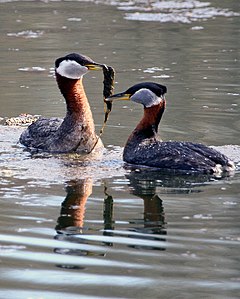 Order: Podicipediformes Family: Podicipedidae Grebes are small to medium-large freshwater diving birds. They have lobed toes and are excellent swimmers and divers. However, they have their feet placed far back on the body, making them quite ungainly on land.
SandgrouseOrder: Pterocliformes Family: Pteroclidae Sandgrouse have small, pigeon-like heads and necks, but sturdy compact bodies. They have long pointed wings and sometimes tails and a fast direct flight. Their legs are feathered down to the toes.
Pigeons and doves Order: Columbiformes Family: Columbidae Pigeons and doves are stout-bodied birds with short necks and short slender bills with a fleshy cere.
Cuckoos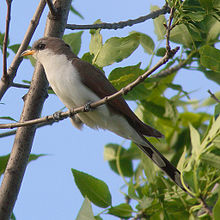 Order: Cuculiformes Family: Cuculidae The family Cuculidae includes cuckoos, roadrunners, and anis. These birds are of variable size with slender bodies, long tails, and strong legs.
Nightjars and alliesOrder: Caprimulgiformes Family: Caprimulgidae Nightjars are medium-sized nocturnal birds that usually nest on the ground. They have long wings, short legs, and very short bills. Most have small feet, of little use for walking, and long pointed wings. Their soft plumage is cryptically colored to resemble bark or leaves.
SwiftsOrder: Caprimulgiformes Family: Apodidae The swifts are small birds which spend the majority of their lives flying. These birds have very short legs and never settle voluntarily on the ground, perching instead only on vertical surfaces. Many swifts have long swept-back wings which resemble a crescent or boomerang.
Rails, gallinules, and coots Order: Gruiformes Family: Rallidae Rallidae is a large family of small to medium-sized birds which includes the rails, crakes, coots, and gallinules. The most typical family members occupy dense vegetation in damp environments near lakes, swamps, or rivers. In general they are shy and secretive birds, making them difficult to observe. Most species have strong legs and long toes which are well adapted to soft uneven surfaces. They tend to have short, rounded wings and to be weak fliers.
CranesOrder: Gruiformes Family: Gruidae Cranes are large, long-legged, and long-necked birds. Unlike the similar-looking but unrelated herons, cranes fly with necks outstretched, not pulled back. Most have elaborate and noisy courting displays or "dances".
Stilts and avocetsOrder: Charadriiformes Family: Recurvirostridae Recurvirostridae is a family of large wading birds which includes the avocets and stilts. The avocets have long legs and long up-curved bills. The stilts have extremely long legs and long, thin, straight bills.
Lapwings and plovers Order: Charadriiformes Family: Charadriidae The family Charadriidae includes the plovers, dotterels, and lapwings. They are small to medium-sized birds with compact bodies, short thick necks, and long, usually pointed, wings. They are found in open country worldwide, mostly in habitats near water.
Sandpipers and allies Order: Charadriiformes Family: Scolopacidae Scolopacidae is a large diverse family of small to medium-sized shorebirds including the sandpipers, curlews, godwits, shanks, tattlers, woodcocks, snipes, dowitchers, and phalaropes. The majority of these species eat small invertebrates picked out of the mud or soil. Different lengths of legs and bills enable multiple species to feed in the same habitat, particularly on the coast, without direct competition for food.
Skuas and jaegersOrder: Charadriiformes Family: Stercorariidae Skuas and jaegers are in general medium to large birds, typically with gray or brown plumage, often with white markings on the wings. They have longish bills with hooked tips and webbed feet with sharp claws. They look like large dark gulls, but have a fleshy cere above the upper mandible. They are strong, acrobatic fliers.
Auks, murres, and puffinsOrder: Charadriiformes Family: Alcidae Alcids are superficially similar to penguins due to their black-and-white colors, their upright posture, and some of their habits; However they are only distantly related to the penguins and are able to fly. Auks live on the open sea, only deliberately coming ashore to nest.
Gulls, terns, and skimmers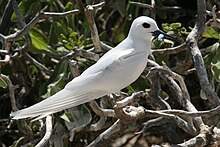 Order: Charadriiformes Family: Laridae Laridae is a family of medium to large seabirds and includes gulls, terns, and skimmers. Gulls are typically gray or white, often with black markings on the head or wings. They have stout, longish bills and webbed feet. Terns are a group of generally medium to large seabirds typically with grey or white plumage, often with black markings on the head. Most terns hunt fish by diving but some pick insects off the surface of fresh water. Terns are generally long-lived birds, with several species known to live in excess of 30 years.
TropicbirdsOrder: Phaethontiformes Family: Phaethontidae Tropicbirds are slender white birds of tropical oceans with exceptionally long central tail feathers. Their long wings have black markings, as does the head.
LoonsOrder: Gaviiformes Family: Gaviidae Loons are aquatic birds, the size of a large duck, to which they are unrelated. Their plumage is largely gray or black, and they have spear-shaped bills. Loons swim well and fly adequately, but are almost hopeless on land, because their legs are placed towards the rear of the body.
AlbatrossesOrder: Procellariiformes Family: Diomedeidae The albatrosses are amongst the largest of flying birds, and the great albatrosses from the genus Diomedea have the largest wingspans of any extant birds.
Southern storm-petrels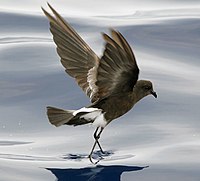 Order: Procellariiformes Family: Oceanitidae The storm-petrels are the smallest seabirds, relatives of the petrels, feeding on planktonic crustaceans and small fish picked from the surface, typically while hovering. The flight is fluttering and sometimes bat-like. Until 2018, this family's three species were included with the other storm-petrels in family Hydrobatidae.
Northern storm-petrelsOrder: Procellariiformes Family: Hydrobatidae Though the members of this family are similar in many respects to the southern storm-petrels, including their general appearance and habits, there are enough genetic differences to warrant their placement in a separate family.
Shearwaters and petrels Order: Procellariiformes Family: Procellariidae The procellariids are the main group of medium-sized "true petrels", characterized by united nostrils with medium septum and a long outer functional primary.
FrigatebirdsOrder: Suliformes Family: Fregatidae Frigatebirds are large seabirds usually found over tropical oceans. They are large, black, or black and white, with long wings and deeply forked tails. The males have colored inflatable throat pouches. They do not swim or walk and cannot take off from a flat surface. Having the largest wingspan-to-body-weight ratio of any bird, they are essentially aerial, able to stay aloft for more than a week.
Boobies and gannetsOrder: Suliformes Family: Sulidae The sulids comprise the gannets and boobies. Both groups are medium-large coastal seabirds that plunge-dive for fish.
Cormorants and shagsOrder: Suliformes Family: Phalacrocoracidae Cormorants are medium-to-large aquatic birds, usually with mainly dark plumage and areas of colored skin on the face. The bill is long, thin, and sharply hooked. Their feet are four-toed and webbed.
Herons, egrets, and bitternsOrder: Pelecaniformes Family: Ardeidae The family Ardeidae contains the herons, egrets, and bitterns. Herons and egrets are medium to large wading birds with long necks and legs. Bitterns tend to be shorter necked and more secretive. Members of Ardeidae fly with their necks retracted, unlike other long-necked birds such as storks, ibises, and spoonbills.
Ibises and spoonbillsOrder: Pelecaniformes Family: Threskiornithidae The family Threskiornithidae includes the ibises and spoonbills. They have long, broad wings. Their bodies tend to be elongated, the neck more so, with rather long legs. The bill is also long, decurved in the case of the ibises, straight and distinctively flattened in the spoonbills.
Osprey Order: Accipitriformes Family: Pandionidae Pandionidae is the fish-eating bird of prey, the osprey. The family is monotypic.
Hawks, eagles, and kites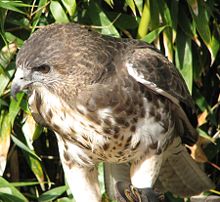 Order: Accipitriformes Family: Accipitridae Accipitridae is a family of birds of prey which includes hawks, eagles, kites, harriers, and Old World vultures. These birds have very large powerful hooked beaks for tearing flesh from their prey, strong legs, powerful talons, and keen eyesight.
Barn-owlsOrder: Strigiformes Family: Tytonidae Barn-owls are medium to large owls with large heads and characteristic heart-shaped faces. They have long strong legs with powerful talons.
OwlsOrder: Strigiformes Family: Strigidae Typical owls are small to large solitary nocturnal birds of prey. They have large forward-facing eyes and ears, a hawk-like beak, and a conspicuous circle of feathers around each eye called a facial disk. Hawaii has one native owl, which is a distinct subspecies.
KingfishersOrder: Coraciiformes Family: Cerylidae Kingfishers are medium-sized birds with large heads, long pointed bills, short legs, and stubby tails.
Falcons and caracarasOrder: Falconiformes Family: Falconidae Falconidae is a family of diurnal birds of prey, notably the falcons and caracaras. They differ from hawks, eagles, and kites in that they kill with their beaks instead of their talons.
New World and African parrotsOrder: Psittaciformes Family: Psittacidae Characteristic features of parrots include a strong curved bill, an upright stance, strong legs, and clawed zygodactyl feet. Many parrots are vividly colored, and some are multi-colored. In size they range from 8 cm (3.1 in) to 1 m (3.3 ft) in length. Most of the more than 150 species in this family are found in the New World.
Old World parrotsOrder: Psittaciformes Family: Psittaculidae Characteristic features of parrots include a strong curved bill, an upright stance, strong legs, and clawed zygodactyl feet. Many parrots are vividly colored, and some are multi-colored. In size they range from 8 cm (3.1 in) to 1 m (3.3 ft) in length. Old World parrots are found from Africa east across south and southeast Asia and Oceania to Australia and New Zealand.
Monarch flycatchers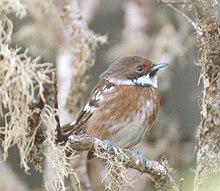 Order: Passeriformes Family: Monarchidae The Monarchinae are a relatively recent grouping of a number of seemingly very different birds, mostly from the Southern Hemisphere, which are more closely related than they at first appear. Many of the approximately 140 species making up the family were previously assigned to other groups, largely on the basis of general morphology or behavior. With the new insights generated by the DNA-DNA hybridisation studies of Sibley and his co-workers toward the end of the 20th century, however, it became clear that these apparently unrelated birds were all descended from a common ancestor. The Monarchinae are small to medium-sized insectivorous passerines, many of which hunt by flycatching.
Crows, jays, and magpiesOrder: Passeriformes Family: Corvidae The family Corvidae includes crows, ravens, jays, choughs, magpies, treepies, nutcrackers, and ground jays. Corvids are above average in size among the Passeriformes, and some of the larger species show high levels of intelligence.
Tits, chickadees, and titmiceOrder: Passeriformes Family: Paridae The Paridae are mainly small stocky woodland species with short stout bills. Some have crests. They are adaptable birds, with a mixed diet including seeds and insects.
LarksOrder: Passeriformes Family: Alaudidae Larks are small terrestrial birds with often extravagant songs and display flights. Most larks are fairly dull in appearance. Their food is insects and seeds.
Reed warblers and allies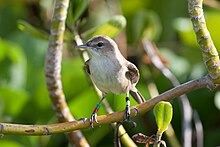 Order: Passeriformes Family: Acrocephalidae The members of this family are usually rather large for "warblers". Most are rather plain olivaceous brown above with much yellow to beige below. They are usually found in open woodland, reedbeds, or tall grass. The family occurs mostly in southern to western Eurasia and surroundings, but also ranges far into the Pacific, with some species in Africa.
SwallowsOrder: Passeriformes Family: Hirundinidae The family Hirundinidae is adapted to aerial feeding. They have a slender streamlined body, long pointed wings, and a short bill with a wide gape. The feet are adapted to perching rather than walking, and the front toes are partially joined at the base.
Bush-warblers and alliesOrder: Passeriformes Family: Cettiidae The members of this family are found throughout Africa, Asia, and Polynesia.
BulbulsOrder: Passeriformes Family: Pycnonotidae Bulbuls are a family of medium-sized passerine songbirds resident in Africa and tropical Asia. These are mostly frugivorous birds.
White-eyes, yuhinas, and allies Order: Passeriformes Family: Zosteropidae The white-eyes are small passerine birds native to tropical and sub-tropical Africa, southern Asia and Australasia. The birds of this group are mostly of undistinguished appearance, their plumage above being generally some dull color like greenish-olive, but some species have a white or bright yellow throat, breast or lower parts, and several have buff flanks. But as indicated by their scientific name, derived from the Ancient Greek for girdle-eye, there is a conspicuous ring around the eyes of many species. They have rounded wings and strong legs. The size ranges up to 15 cm (6 inches) in length. All the species of white-eyes are sociable, forming large flocks which only separate on the approach of the breeding season. Though mainly insectivorous, they eat nectar and fruits of various kinds.
Laughingthrushes and alliesOrder: Passeriformes Family: Leiothrichidae The members of this family are diverse in size and coloration, though those of genus Turdoides tend to be brown or grayish. The family is found in Africa, India, and southeast Asia.
Hawaiian honeyeaters Order: Passeriformes Family: Mohoidae Honeyeaters prefer to flit quickly from perch to perch in the outer foliage, stretching up or sideways or hanging upside down at need. They have a highly developed brush-tipped tongue, which is frayed and fringed with bristles which soak up liquids readily. The tongue is flicked rapidly and repeatedly into a flower, the upper mandible then compressing any liquid out when the bill is closed. The Kauaʻi ʻōʻō was the last species to survive. It was last seen in 1987.
Mockingbirds and thrashersOrder: Passeriformes Family: Mimidae The mimids are a family of passerine birds which includes thrashers, mockingbirds, tremblers, and the New World catbirds. These birds are notable for their vocalization, especially their remarkable ability to mimic a wide variety of birds and other sounds heard outdoors. The species tend towards dull grays and browns in their appearance.
Starlings Order: Passeriformes Family: Sturnidae Starlings are small to medium-sized Old World passerine birds with strong feet. Their flight is strong and direct and most are very gregarious. Their preferred habitat is fairly open country, and they eat insects and fruit. The plumage of several species is dark with a metallic sheen.
Thrushes and allies Order: Passeriformes Family: Turdidae The thrushes are a group of passerine birds that occur mainly but not exclusively in the Old World. They are plump, soft plumaged, small to medium-sized insectivores or sometimes omnivores, often feeding on the ground. Many have attractive songs.
Old World flycatchersOrder: Passeriformes Family: Muscicapidae The Old World flycatchers are a large family of small passerine birds restricted to the Old World. These are mainly small arboreal insectivores, many of which, as the name implies, take their prey on the wing. The appearance of these birds is highly varied, but they mostly have weak songs and harsh calls. The nest of most is a well-constructed cup in a tree or hedge.
Waxbills and allies Order: Passeriformes Family: Estrildidae The Estrildidae are small passerine birds of the Old World tropics and Australasia. They are gregarious and often colonial seed eaters with short, thick, but pointed bills. They are all similar in structure and habits, but vary widely in plumage colors and patterns. All the estrildids build large domed nests. Most are sensitive to cold and require a warm, usually tropical, habitat.
Old World sparrowsOrder: Passeriformes Family: Passeridae Old World sparrows are small passerine birds. In general, sparrows tend to be small plump brownish or grayish birds with short tails and short powerful beaks. Sparrows are seed eaters, but they also consume small insects.
Wagtails and pipitsOrder: Passeriformes Family: Motacillidae Motacillidae is a family of small passerine birds with medium to long tails. They include the wagtails, longclaws, and pipits. They are slender ground-feeding insectivores of open country.
Finches, euphonias, and allies  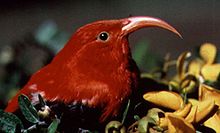  Order: Passeriformes Family: Fringillidae Finches are seed-eating passerine birds, that are small to moderately large and have a strong beak, usually conical and in some species very large. All have twelve tail feathers and nine primaries. These birds have a bouncing flight with alternating bouts of flapping and gliding on closed wings, and most sing well. Most of the members of this family listed here are "Hawaiian honeycreepers". These endemic birds were formerly placed in their own family, Drepanididae. The wide range of bills in this group, from thick finch-like bills to slender downcurved bills for probing flowers, have arisen through adaptive radiation, where an ancestral finch has evolved to fill a large number of ecological niches.
Longspurs and snow buntingsOrder: Passeriformes Family: Calcariidae The Calcariidae are a group of passerine birds that were traditionally grouped with the New World sparrows, but differ in a number of respects and are usually found in open grassy areas.
New World sparrowsOrder: Passeriformes Family: Passerellidae Until 2017, these species were considered part of the family Emberizidae. Most of the species are known as sparrows, but these birds are not closely related to the Old World sparrows which are in the family Passeridae. Many of these have distinctive head patterns.
Troupials and alliesOrder: Passeriformes Family: Icteridae The icterids are a group of small- to medium-sized, often colorful passerine birds. Most species have black as a predominant plumage color, often enlivened by yellow, orange, or red.
Cardinals and alliesOrder: Passeriformes Family: Cardinalidae The cardinals are a family of robust, seed-eating birds with strong bills. They are typically associated with open woodland. The sexes usually have distinct plumages.
Tanagers and allies Order: Passeriformes Family: Thraupidae The tanagers are a large group of small to medium-sized passerine birds restricted to the New World, mainly in the tropics. Many species are brightly colored. They are seed eaters, but their preference tends towards fruit and nectar.
See also
Notes
References
Further reading
External links |